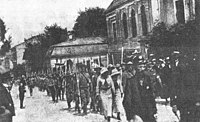Plast
[citation needed] Born during great social and political upheavals in Europe, Ukrainian Plast came into being to fulfill specific national aims, unlike other Scout organizations.
[citation needed] By 1916, its membership exceeded 10,000, and it was a fully developed and functioning organization, consisting of separate branches of Boy Scouts and Girl Guides.
The subsequent years witnessed a great upswing in Scouting, as it spread into the towns and communities where it had been previously unknown, mainly in the newly freed central provinces of Ukraine.
Hundreds, if not thousands, of boys, inspired by the ideals of service to God and Country which Scouting engenders, volunteered to join the armed forces, fighting on several fronts, and many gave their lives.
[citation needed] The Soviet victory in the civil war in 1922 led to an immediate abolition of all non-communist scout activities in this region.
In areas later to become western Ukraine, which included parts of Czechoslovakia and Poland, the Scout movement emerged from the ruins of war with renewed vitality.
In spite of numerous obstacles, Plast developed rapidly in the Polish areas, with high levels of membership among students, farmers and workers.
A key sponsor was Metropolitan Andrey Sheptytsky, the Archbishop of the Ukrainian Greek Catholic Church (1901–1944), who donated a campsite called "Sokil" in the Carpathian Mountains.
In the late 1920s, external pressure on the part of the Polish authorities seriously impaired further growth of Plast on its territory, and eventually led to an outright abolition of Ukrainian Scouting in 1928 in the Volyn region, and in Halychyna in 1930.
[1] The Plast groups in Carpathian Ruthenia and Prague were members of the Union of Junak Scouts and Guides of the Republic of Czechoslovakia and through this federation of the two World organizations.
Plast activities continued to be undertaken, via the Commission of Educational Campsites, the "Ridna Shkola" and published in the journal Vohni.
During the years under Communism and the Soviet Union, Scouting was banned in Ukraine, but the Plast organization continued to exist in exile around the world.
Subsequent anniversaries were celebrated in 1967 at Batyrin, South Bolton, Quebec, and participants performed at Expo67 honoring the Canadian Centennial, and 1972 (again in East Chatham, New York), 1978 (Alberta, Canada) and every five years thereafter.
The location of Plast's global headquarters would vary based on the leadership elected at each Holovna Plastova Rada, although the centers of administration tended to be New York City and Toronto, Canada.
In addition to creating over a dozen campsites, Plast members built or acquired over 30 facilities or domivky where they could hold activities, generally on a weekly basis.
The first Plast camp was organized in the summer of 1989 and was raided by the Soviet secret police (KGB); several Scouts were beaten and arrested.
Since the end of Soviet communism and the birth of an independent Ukraine in 1991, Ukrainian Plast Scouting has been growing rapidly in every corner of the country.
The 95th anniversary jubilee (Ukrainian: ЮМПЗ, YUMPZ) occurred in August 2007, with a Zustrich at the Plastova Sich campsite in Grafton, Ontario, Canada.
All duties in Ukrainian Scouting, from local to the National Council levels, are performed by a combination of volunteer workers and paid professionals.
The congress, which gathered Scout representatives from most regions of Ukraine, approved the Constitution of NOSU and elected its governing bodies.
He also met with the Deputy Minister of Family, Youth and Sports, one of the founding members of one of the Scout associations, who confirmed full support of the authorities to NOSU.
NOSU membership is open to girls and boys, women and men, in three age sections: Cubs (6–10), Scouts (11–16) and Rovers (16–24).





